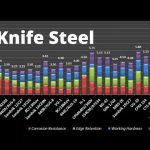
fccaa2bfef2109a69d653ac706cbc972
Pocket knives are a popular tool for everyday use, and the type of steel used in their construction can have a major impact on their performance. In this article, we’ll explore the different types of steel used in pocket knives and discuss the advantages and disadvantages of each. We’ll also look at how the steel used in pocket knives affects their durability, sharpness, and corrosion resistance. Finally, we’ll provide some tips on how to choose the right type of steel for your pocket knife.
What steel is used for pocket knives
Pocket knives are a popular tool for everyday use, and the type of steel used in their construction is an important factor in their performance. The most common type of steel used in pocket knives is stainless steel. Stainless steel is a type of steel alloy that contains a minimum of 10.5% chromium, which gives it its corrosion-resistant properties. It is also highly durable and can withstand wear and tear.
Other types of steel used in pocket knives include carbon steel, tool steel, and high-speed steel. Carbon steel is a type of steel alloy that contains a higher percentage of carbon than stainless steel, making it harder and more durable. Tool steel is a type of steel alloy that is designed for use in tools and is highly resistant to wear and tear. High-speed steel is a type of steel alloy that is designed for use in high-speed cutting tools and is highly resistant to heat and wear.
The type of steel used in a pocket knife will depend on the intended use of the knife. For example, a pocket knife used for everyday tasks such as opening packages or cutting rope may be made from stainless steel, while a pocket knife used for more demanding tasks such as hunting or camping may be made from carbon steel or tool steel. High-speed steel is typically used in pocket knives designed for more specialized tasks such as wood carving or metalworking.
When choosing a pocket knife, it is important to consider the type of steel used in its construction. Different types of steel offer different levels of durability and performance, so it is important to choose the type of steel that best suits your needs.
What is the hardest steel for a pocket knife
Pocket knives are a popular tool for everyday use, and the type of steel used in the blade can make a big difference in its performance. The hardest steel for a pocket knife is a type of stainless steel called CPM S110V. This steel is known for its superior edge retention and corrosion resistance, making it an ideal choice for a pocket knife.
CPM S110V is a type of stainless steel that is made using a process called Crucible Particle Metallurgy (CPM). This process involves melting the steel and then cooling it in a controlled environment. This process helps to create a more uniform and consistent steel that is harder and more durable than other types of stainless steel.
CPM S110V is a high-end steel that is often used in high-end pocket knives. It is known for its superior edge retention and corrosion resistance, making it an ideal choice for a pocket knife. It is also very difficult to sharpen, so it is best suited for those who are experienced with sharpening knives.
CPM S110V is a great choice for a pocket knife, but it is important to remember that it is not the only option. There are other types of stainless steel that can be used for pocket knives, such as AUS-8 and VG-10. Each type of steel has its own advantages and disadvantages, so it is important to do your research and choose the steel that is best suited for your needs.
No matter what type of steel you choose for your pocket knife, it is important to take good care of it. Regular maintenance and sharpening will help to ensure that your pocket knife will last for many years to come.
What is the difference between 1080 and 1095 steel
Steel is a popular material used in many industries, from construction to manufacturing. Two of the most common types of steel are 1080 and 1095. While both are strong and durable, there are some key differences between the two.
1080 Steel
1080 steel is a medium-carbon steel that is often used in the production of knives and swords. It is a relatively soft steel, making it easier to shape and sharpen. It is also relatively inexpensive, making it a popular choice for many knife makers. However, it is not as strong as 1095 steel and is more prone to corrosion.
1095 Steel
1095 steel is a high-carbon steel that is often used in the production of blades. It is much harder than 1080 steel, making it more difficult to shape and sharpen. It is also more expensive, but it is much stronger and more resistant to corrosion. This makes it a popular choice for many knife makers, as it is more durable and can hold an edge better.
Conclusion
1080 and 1095 steel are both popular choices for knife makers, but they have some key differences. 1080 steel is softer and easier to shape and sharpen, but it is not as strong and is more prone to corrosion. 1095 steel is harder and more expensive, but it is much stronger and more resistant to corrosion.
What is the difference between 1084 and 1095 steel
1084 and 1095 steel are both high carbon steels, but they have different properties and applications. 1084 steel is a medium-to-high carbon steel with a carbon content of 0.84%. It is a popular choice for forging blades and swords due to its high strength and toughness. 1095 steel is a high carbon steel with a carbon content of 0.95%. It is often used for making knives and other cutting tools due to its superior edge retention and wear resistance.
Toughness is one of the main differences between 1084 and 1095 steel. 1084 steel is known for its toughness and is often used for making swords and blades that need to be able to withstand impacts. 1095 steel is not as tough as 1084 steel, but it is much harder and has better wear resistance. This makes it a better choice for making knives and other cutting tools.
Heat treatment is another difference between 1084 and 1095 steel. 1084 steel is relatively easy to heat treat and can be hardened to a Rockwell hardness of 58-60. 1095 steel is much harder to heat treat and can be hardened to a Rockwell hardness of 60-62. This makes 1095 steel more suitable for making knives and other cutting tools that need to hold an edge.
Cost is also a factor when choosing between 1084 and 1095 steel. 1084 steel is generally less expensive than 1095 steel, making it a more cost-effective choice for many applications. 1095 steel is more expensive, but it is also more durable and has better edge retention.
In conclusion, 1084 and 1095 steel are both high carbon steels with different properties and applications. 1084 steel is tougher and easier to heat treat, making it a popular choice for forging blades and swords. 1095 steel is harder and has better wear resistance, making it a better choice for making knives and other cutting tools. 1084 steel is generally less expensive than 1095 steel, but 1095 steel is more durable and has better edge retention.
Thank you for reading about the different types of steel used in pocket knives. We hope this article has been helpful in understanding the various types of steel and their uses. Goodbye and have a great day!








